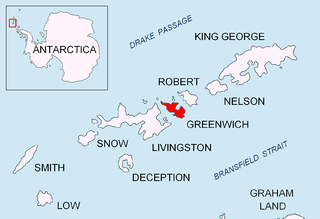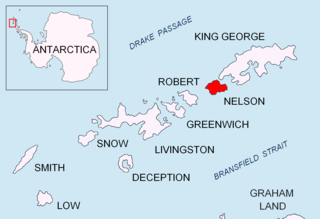
Quito Glacier is a glacier draining the northeast slopes of Mount Plymouth and flowing northeastwards into the sea west of Canto Point in north Greenwich Island, South Shetland Islands. It was named after the capital of Ecuador, c. 1990, by the Ecuadorian Antarctic Expedition.

Syrezol Rocks is a small group of rocks lying 1 mile (1.6 km) west of Martins Head at the east side of the entrance to Admiralty Bay, King George Island, in the South Shetland Islands. In 1908-10, the Fourth French Antarctic Expedition under Jean-Baptiste Charcot assigned the name "Cap Syrezol" to a feature between what is now Martins Head and Chabrier Rock. Since there is no distinctive point or cape in this position, the name has been applied to these rocks in order to preserve Charcot's naming in the area in which it was originally given.
Telefon Point is a point west of the entrance to Admiralty Bay, 2 miles (3.2 km) southwest of Demay Point, King George Island. Named in 1977 by United Kingdom Antarctic Place-Names Committee (UK-APC) in association with Telefon Rocks, which lie offshore east of this point.

Makresh Rocks are a group of rocks situated 1.8 km (1.12 mi) northeast of Treklyano Island off the northeast coast of Robert Island, South Shetland Islands. Extending 600 m (656 yd) in west-southwest to east-northeast direction, and 270 m (295 yd) in northwest-southeast direction. The solitary Salient Rock 62°21′24″S 59°20′59″W is lying 1.73 km (1.07 mi) east of the midpoint of Makresh Rocks and 2 km (1.24 mi) northeast of Smirnenski Point.

Koynare Rocks are a small group of rocks in Hero Bay off the north coast Livingston Island in the South Shetland Islands, Antarctica situated 7.5 km (4.66 mi) northeast of Siddins Point, 5.3 km (3.29 mi) northwest of Bezmer Point, and 1.4 km (0.87 mi) south of Miladinovi Islets. The area was visited by early 19th century sealers.

Voluyak Rocks is a chain of rocks off the north coast of Greenwich Island in the South Shetland Islands, Antarctica situated 400 m (440 yd) north of Pavlikeni Point. Extending 1.9 km (1.2 mi) in southeast-northwest direction.

Cape Conway is the rounded low and ice-free tipped cape forming the south extremity of Snow Island in the South Shetland Islands, Antarctica. It is a south entrance point for Boyd Strait. Tooth Rock rising to 85 m (279 ft) and lying 1.94 km (1.21 mi) to the south is the largest in a group of rocks extending 2.7 km (1.7 mi) from the cape. The area was visited by 19th century sealers.

Sally Rocks is a small group of rocks trending southwestwards in South Bay just off the west coast of Hurd Peninsula, Livingston Island in the South Shetland Islands, Antarctica.

Figueroa Point is an ice-free point at the northeast extremity of Greenwich Island in the South Shetland Islands, Antarctica forming the southeast side of the entrance to Galápagos Cove. Dovizio Rock is lying 190 m (210 yd) to the northeast, Ibar Rocks are centred 860 m (940 yd) to the southeast, Bonert Rock 62°27′01.8″S 59°42′58.3″W is 730 m (800 yd) to the south-southeast and Rosales Rocks 62°26′57.5″S 59°43′16.4″W are 500 m (550 yd) south by east of Figueroa Point. The area was visited by early 19th century sealers.

Baranowski Glacier is a glacier flowing east into Admiralty Bay, King George Island, northwest of Demay Point. It was named by the Polish Antarctic Expedition after Stanisław Baranowski (1935–78), Polish glaciologist who died on King George Island as a result of an accident at the Henryk Arctowski Polish Antarctic Station while a member of the 1977–78 expedition.

Orsoya Rocks is the group of rocks off the north coast of Robert Island in the South Shetland Islands, Antarctica, situated west-northwest of Mellona Rocks, north-northeast of Milev Rocks and east-northeast of Opaka Rocks, and extending 650 m in northwest-southeast direction and 500 m in northeast-southwest direction.

Bulbur Glacier is a glacier in south-central Thurston Island; it flows south along the west side of Boker Rocks into O'Dowd Cove. It was named by the Advisory Committee on Antarctic Names after E.R. Bulbur, Photographer's Mate in the Eastern Group of U.S. Navy Operation Highjump, which obtained aerial photographs of Thurston Island and adjacent coastal areas, 1946–47.

Tu Rocks is a two low rocks lying in Maxwell Bay 2 nautical miles (3.7 km) east of the southwest end of King George Island, in the South Shetland Islands. The name appears to have been given by DI personnel on the Discovery II who charted the rocks in 1935. Tu is apparently phonetic for two.

Domeyko Glacier is a glacier flowing southeast into Mackellar Inlet, Admiralty Bay, King George Island, in the South Shetland Islands. It was named by the Polish Antarctic Expedition, 1980, after Ignacy Domeyko, a Polish born explorer of the Andes and sometime Professor of Chemistry and Mineralogy, and Rector, of the University of Chile, Santiago.

The Pointers is a pair of rocks off the northwest coast of Rugged Island, lying between Eddystone Rocks and Start Point, Livingston Island in the South Shetland Islands, Antarctica.

Sphinx Hill is a conspicuous, isolated black hill, 145 m, standing 1.5 nautical miles (2.8 km) north-northwest of Demay Point on King George Island, South Shetland Islands. First charted by the French Antarctic Expedition under Charcot, 1908-10. The descriptive name was given by the United Kingdom Antarctic Place-Names Committee (UK-APC) following a survey by Lieutenant Commander F.W. Hunt, Royal Navy, in 1951-52.
Maxwell Bay, also called Fildes Bay and Guardia Nacional Bay is a bay 19 km (12 mi) long, lying between King George Island and Nelson Island, in the South Shetland Islands of Antarctica. The main entrance to the bay is at the south-east side and is wide open; Fildes Strait on the north-west side is encumbered by rocks and is only navigable by boats. The name "Maxwells Straits" was given to this bay and to Fildes Strait by British sealing captain James Weddell in 1822–24, for Lieutenant Francis Maxwell who had served with Weddell in 1813–14. The name was altered and limited to the feature here described by the UK Antarctic Place-Names Committee in 1960.

Pingvin Rocks is the group of rocks in Morton Strait off the northeast coast of Snow Island in the South Shetland Islands, Antarctica extending 670 m in west–east direction and 300 m in south–north direction. The area was visited by early 19th-century sealers.

Rotalia Island is the rocky island off the north coast of Nelson Island in the South Shetland Islands, Antarctica extending 310 m in southeast-northwest direction and 250 m in southwest-northeast direction.



![]()













